February in the Tearoom
The month of February is often identified with aspects of the lunar calendar, kyū-reki, 旧暦, old-calendar, which can cause a little confusion, and can cause things to be out of sync with events that are associated with the full moon. The second month of the lunar calendar is called Kisaragi, and is written with the Kanji, 如月, which is read as Kisaragi, but according to the Kanji, it should be read jo-getsu, likeness-month. The word ki-sara-gi can be written with the Kanji, 衣更着, clothes-more-wear, because it is the coldest time of the year.
The year 2022 has the first day of February coinciding with the first day of the New Year of the lunar calendar. This brings about a cluster of events that may create even more disorientation. The Lunar New Year, Kyū-shō-gatsu, 旧正月, Old-true-month, and Setsu-bun, 節分, Season-divide, on February 3rd , which is the eve of Ri-sshun, 立春, Start-spring, occur almost simultaneously. Risshun is the time to start counting 88 days until Hachi-jū-hachi-ya, 八十八夜, cha-tsumi, 茶摘, tea-pick. In the realm of Chanoyu, during February, the dai-ro, 大炉, is opened.
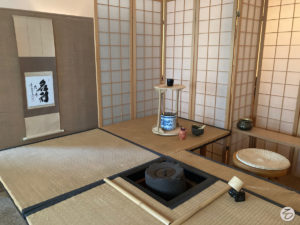
Illustrated in the above picture of Garandō: kake–jiku, 掛軸, hang-scroll with shiki-shi, 色紙, color-paper; pasteboard with calligraphy, ‘Mei ri tomo kyū’, 名利共休, Name riches both leave, by Ko-bayashi Tai-gen, 小林太玄, Small-grove Great-mystery, abbot of the Ō-bai-in, 黄梅院, Yellow-apricot-temple, a sub-temple of Dai-toku-ji, 大徳寺, Great-virtue-temple, Kyōto. The phrase, mei ri tomo kyū, is the origin of Rikyū’s name – 利休, Riches-leave.
The tea utensil display stand is a Rikyū maru-joku, 丸卓, round-stand, poplar wood, and was made by Joseph van Benten, Chestnut Hill, Mass.
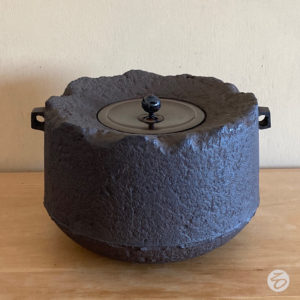
The contrast between the rugged, timeworn, ‘rusty,’ aged quality of the kama and the refined, smooth, pristine quality of the lid is a superb example of wabi, 侘び. As challenging to define as ‘art’, wabi is the esthetic response to the comparison of rustic and refined, dead and living. A contrast of a just-picked flower in an ancient bronze vase evokes a wabi feeling. The clean freshness enhances the aged, rough appearance of the other, as well as the reverse, the refinements enhanced. Wabi is a comparison of two or more things.
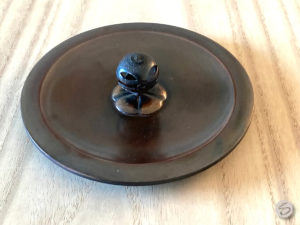
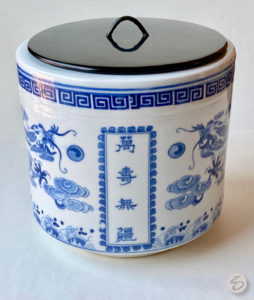
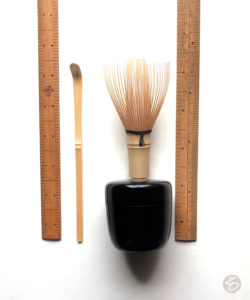
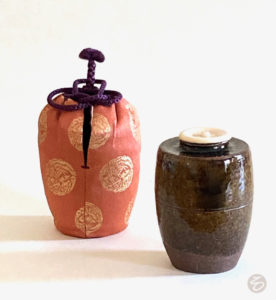

The bowl was called ‘muki-guri,’ ムキ栗, with katakana for muki, which questions whether it should be the Kanji for muki, 剥, meaning peel. There may be wordplay on ku-ri, 庫裏, storehouse[of consciousness]-inner, Buddhist priest’s residence, as well as wordplay on muki, 向き, meaning facing. Another of Rikyū’s chawan, called ‘Tō-yō-bō’, 東陽坊, East-yang-quarter, a priest’s residence Teahouse at Ken-nin-ji, 建仁寺, Build-benevolence-temple, the first Zen temple in Kyōto. Rikyū’s friend, for whom he named the bowl, had the same name as his residence, Tōyōbō. Names in Japan are often taken by the location of the resident: the celebrated Zen priest, Hyakujō, is known by the name of the mountain where is temple was located.
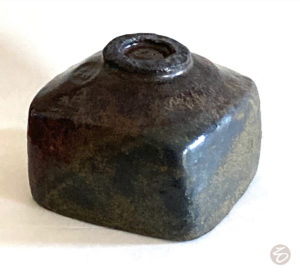

Many early Raku chawan were modelled after kama that were turned upside down. Rikyū had a square kama that became the model for a chawan made by Chō-ji-ro, 長次郎, Long-next-son. Beyond the most common round shape, which never seems repetitious, Rikyū seems to have combined similar unusual shapes such as the square kama and square chawan. It is the custom in Chanoyu, which is typically Japanese, to avoid repetition, as in the potter’s name 佐々木 , the Kanji for sa, 佐, is not repeated, but is substituted by the character, 々, rather like a ditto sign.
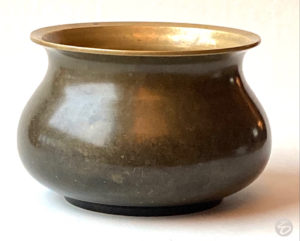
Six is generally an unlucky number in part because it can be divided equally in half, and is therefore In, negative, which in truth is not actually un-lucky. All even numbers are In, odd numbers are Yō, positive, because they cannot be divided equally. Six, in Japanese is roku, which is a homonym for 碌, worthy, good, etc., 禄, record.

The length of the chashaku is equal to the distance between the fushi, 節, node, of the hishaku and where it penetrates the cup. The root-end of the handle of the ladle is at the end of the handle. The root-end of the chashaku is at the scoop end. It is interesting to note the like all chashaku, the scoop end is curved, just as there is a curve of the hishaku handle where it penetrates the side of the cup. These two utensils are both shaku, 杓, ladles, as they transport water and tea. And yet they are opposites in special ways.
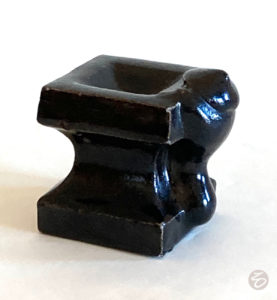
This style is one of Rikyū’s seven objects that he used as futaoki, and almost every object has some association with water, physically or intentionally. The pictured object is modelled on an incense burner in the form of a well curb, i-do, 井戸, well-door, which is a kind of open box surrounding a well hole. The figure is an enlightened monk who has given up the routine of the temple, and stands guard by a well so that children will not fall in. In China, especially, children are often depicted playing in gardens and by bodies of water, ponds, wells, bowls, etc. The aspect of water is implied, although as an incense burner it is more closely aligned with fire.
The ro, 炉, hearth, as at top, is Rikyū’s standard of 14 sun kane-jaku. Two lengths of bamboo are placed on the floor to approximate the size of the dai-ro, 大炉, great-hearth, as conceived by Gen-gen-sai, 玄々斎, Mystery-mystery-abstain, XI Iemoto, Urasenke. The size of the dairo is 14 sun kujira-jaku. The kama remains in it relatively standard place, leaving the rest of the ro-dan, 炉壇, hearth-foundation, open to hold a large ceramic tile as a deflector of the fire, shimeshi-bai, 湿し灰, damp-ash, and charcoal for rebuilding the fire. It was a surprise, to me, to learn that the dairo was also 14 sun, when measured with the larger kujira-jaku. The ratio of the standard ro and the dairo is 8 to 10, which is a manifestation of ya-ta, 八咫, eight-span, like the Ya-ta kagami, 八咫鏡, Eight-span mirror, the sacred Shintō symbol of Amaterasu, the sun goddess. Yata is emblematic of infinite vastness.
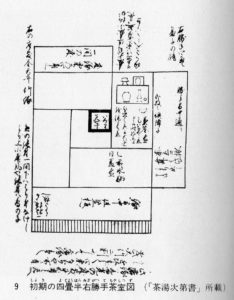
Gyaku-gatte has its origins in old Buddhist Tea presentations that were prevalent in the domestic life of Tea people. In the time of Gengensai, the six-mat room adjoining Totsu-totsu-sai, 咄々斎, Tsk-tsk-abstain, was transformed into a space where the ro was enlarged and moved to the opposite side, creating gyaku-gatte reverse-prevail-hand. The ro opening was enlarged from the standard 14 sun kane-jaku to 14 sun kujira-jaku, and was called dai-ro, 大炉, large-hearth. The kama often has a larger, more open mouth.
Having fire located on the left is like the old arrangement of Tea utensils in temples. The ro kama is, or emulates, the older large kama that was with the larger furo. The large furo was thought to be too big for tea rooms with tatami, so furo and kama were made smaller. But, the large kama was not abandoned. The ro was created to accommodate the large temple kama. Rikyū established the size of the opening of the ro at 14 sun kane-jaku. It is important to note that the dai-ro room had no tokonoma, which demonstrates that a Tearoom does not truly need a separate tokonoma. For Gengensai, the room itself was dedicated to a higher spirit, like a tokonoma. For a place to hang a scroll, a two-panel byō-bu, 屏風, wall-wind, is placed in the northeast corner of the room. If gyaku-gatte was opened for the month of February, and intended to have a Buddhist sense, what Buddhist event happened in the February? The death and nirvana of the Buddha. According to the old calendar, this occurred on the full moon of the second month. In Japan, and elsewhere, it is most often observed on the 15th of March. This will be detailed in a future article.
